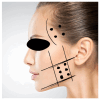Intramuscular Botulinum Toxin as an Adjunct to Arthrocentesis with Viscosupplementation in Temporomandibular Disorders: A Proof-of-Concept Case-Control Investigation
- PMID: 39195774
- PMCID: PMC11359951
- DOI: 10.3390/toxins16080364
Intramuscular Botulinum Toxin as an Adjunct to Arthrocentesis with Viscosupplementation in Temporomandibular Disorders: A Proof-of-Concept Case-Control Investigation
Abstract
Background: The reduction in joint load is a potential beneficial factor in managing osteoarthritis of the temporomandibular joint (TMJ). This paper aims to compare the effectiveness of the intramuscular injection of botulinum toxin (BTX-A) as an adjunct to TMJ arthrocentesis plus viscosupplementation with arthrocentesis plus viscosupplementation alone in the management of TMJ osteoarthritis.
Methods: A pilot clinical retrospective study examined TMJ osteoarthritis treatments. Patients were divided into two groups: Group A received BTX-A injections and arthrocentesis with viscosupplementation, while Group B received only arthrocentesis with viscosupplementation. The study assessed outcomes based on mouth opening (MO), pain at rest (PR), pain at mastication (PF), and masticatory efficiency (ME) at various time points (baseline (T0), 1 week (T1), 2 weeks (T2), 3 weeks (T3), and 4 weeks (T4)) up to 2 months after treatment.
Results: The study included two groups, each with five patients. Group A received five weekly sessions of arthrocentesis plus viscosupplementation and a single BTX-A injection during the first arthrocentesis appointment. Group B underwent the five-session protocol of arthrocentesis plus viscosupplementation alone. MO, PF, PR, and ME improved quickly in T2 in both groups, but the improvement was of greater importance over the following weeks and lasted longer in Group A.
Conclusions: Arthrocentesis with viscosupplementation associated with BTX-A was found to be more effective than arthrocentesis alone in improving clinical outcomes. This suggests that patients with TMJ osteoarthritis and myofascial pain may benefit from reduced muscle tone and joint load.
Keywords: arthrocentesis; botulinum toxin; hyaluronic acid; orofacial pain; osteoarthritis; temporomandibular disorders; temporomandibular joint.
Conflict of interest statement
The authors declare no conflicts of interest.
Figures









References
-
- Nazzal H., Baccar M., Ziad T., Al-Musfir T., Al Emadi B., Matoug-Elwerfelli M., Narasimhan S., Khan Y., Reagu S. Prevalence of anxiety, sleep bruxism and temporomandibular disorders during COVID-19 in Qatari children and adolescents: A cross-sectional study. Eur. Arch. Paediatr. Dent. 2023;24:787–795. doi: 10.1007/s40368-023-00847-6. - DOI - PMC - PubMed
-
- De la Torre Canales G., Bonjardim L.R., Poluha R.L., Carvalho Soares F.F., Guarda-Nardini L., Conti P.R., Manfredini D. Correlation Between Physical and Psychosocial Findings in a Population of Temporomandibular Disorder Patients. Int. J. Prosthodont. 2020;33:155–159. doi: 10.11607/ijp.5847. - DOI - PubMed
-
- Zani A., Lobbezoo F., Bracci A., Djukic G., Guarda-Nardini L., Favero R., Ferrari M., Aarab G., Manfredini D. Smartphone-based evaluation of awake bruxism behaviours in a sample of healthy young adults: Findings from two University centres. J. Oral Rehabil. 2021;48:989–995. doi: 10.1111/joor.13212. - DOI - PMC - PubMed
MeSH terms
Substances
LinkOut - more resources
Full Text Sources
Medical
Research Materials

